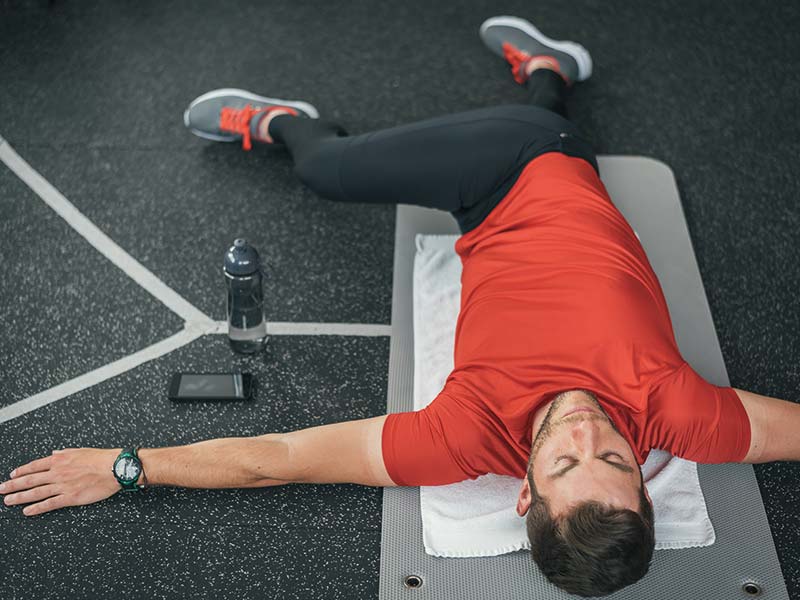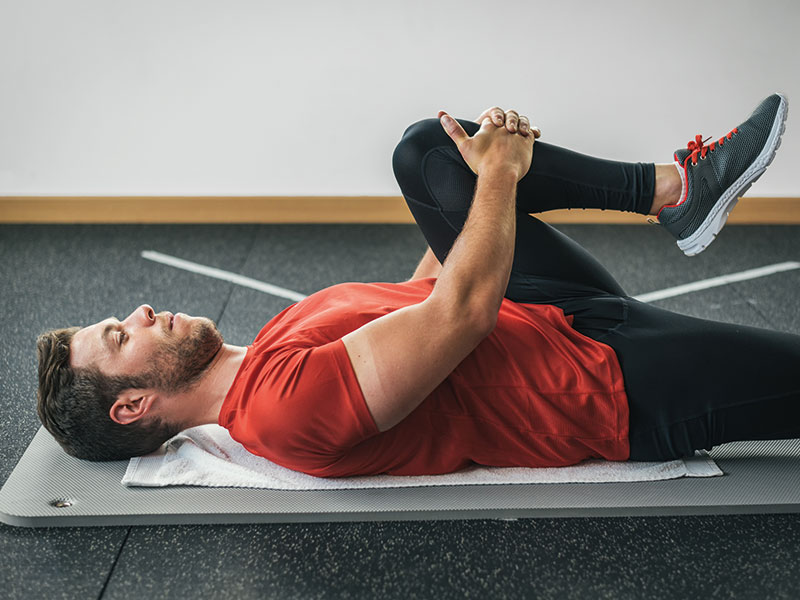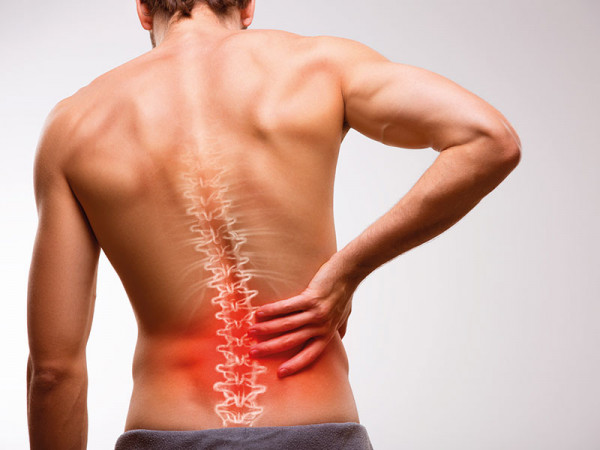When your back hurts, your concentration decreases and you feel restricted. The causes can be strained muscles and ligaments or wear and tear of the spine and intervertebral discs. Quick help is needed, if possible without tablets, so that the pain does not get worse. This is why it is so important to strengthen the back muscles and thus prevent pain directly.
The spine - a supporting force
We owe the upright walk to the spine. It stabilizes the back and is also responsible for our ability to stand, walk, jump and sit.
The spinal column consists of 33 to 34 vertebrae, 24 of which are mobile and between 9 and 10 are joined together. It runs from the neck over the back down to the buttocks. It can be divided into 5 sections:
- The cervical spine (HWS) with 7 cervical vertebrae
- The thoracic spine (BWS) with 12 thoracic vertebrae
- The lumbar spine (LWS) with 5 lumbar vertebrae
- The sacrum with 5 sacral vertebrae
- The coccyx with 4 to 5 coccyx vertebrae
The individual vertebrae: The vertebrae of the cervical spine, thoracic spine and lumbar spine have the same bony structure, they only differ in shape and size. Each vertebra consists of a vertebral body, to which the vertebral arch is attached. The cavity that is created in the middle of the vertebrae is called the spinal canal. The spinal cord is well protected in it. The individual vertebral bodies are connected by movable joints. The cartilaginous discs keep these joints mobile.
The double S shape: The natural curvature of the spine has an important function. It cushions forces that arise from movement: for example when running or jumping. The curvature therefore makes our spine more stable and resilient.
Causes & Symptoms: What causes back pain and how does it manifest itself?
Back pain can have far-reaching causes: from drafts to psychological strain, stress to a serious malposition of the spine. A distinction is made between acute and chronic back pain.
Badly trained back and abdominal muscles are often responsible for acute back problems. If the muscles are overstrained, tension in the individual muscle fibres, the so-called trigger points, can be felt. The result: pain.
Acute back problems can usually be clarified quickly: The causes are easy to understand and are eliminated after some time. Circumstances that may currently be more demanding and therefore cause stress or even anxiety can result in symptoms such as pain and tension. If your pain lasts longer than 6 weeks, it is no longer called acute back pain but chronic pain.
Chronic back problems are often not directly perceived as such. They accompany you through the day and almost belong to it. The triggers are often malpositions of the spine, hard physical work, or imbalances, such as the permanent one-sided carrying of heavy bags.
The overview shows a few typical symptoms of back pain and their causes:
- Tension, shortened muscles, pressure pain in the lower and upper back: Lack of exercise
- Shoulder blade pain, pain in the upper back, restricted movement, hunchback: Imbalance (dysbalance)
- Tension pain, cramps, neck pain, hunchback: stress or anxiety
- Stiff neck, restricted neck movement, pulling, stabbing: Draught
Back problems: Who does it affect particularly frequently?
Professional group
The physically active: cleaning staff, craftsmen and women, construction workers, housewives or househusbands
Very often physically hard working people have to lift, push, carry or generally put their body into positions that are unhealthy in the long run. A wrong posture then leads to pain - especially in the back. The pain is felt in the lower and upper as well as in the neck and shoulder area.
The sitters: Office, truck drivers, cashiers
This group also often strains its back without knowing it. Sitting at a desk or with your hands on the steering wheel for hours is not good for your body. Also here: The wrong posture, too little stretching and hardly any compensation cause back pain.
The persistent ones: Hairdressers, bakers, caterers
Standing for long periods of time also works on the back. The lower area in particular is subject to heavy strain. Again the posture plays a decisive role. In general, the body needs variety: sitting, standing, lying, movement, everything is important. Depending on the occupational group, compensation should be provided.
Generation
The older generation: The likelihood of suffering from back pain becomes more regular with age. The lifelong strain on the spine does not go unnoticed. Vertebrae can slip or even break and signs of wear and tear of the joints occur more frequently. It is therefore true that you should take more care of yourself and your back as you get older.
+++ Staying fit in old age - why sport is so important now +++
The young generation: Back pain does not only plague older people. Young people, even children, complain about back problems. For many, back pain can be attributed to a lack of physical exercise. Others have a dysbalance, for example because of a school bag that is too heavy. In some cases, however, it is also due to hormones and growth.
Gender
Although back pain can affect any sex, women are more frequently affected than men, according to a study by the Robert Koch Institute.
Menstruation, pregnancy/birth, menopause - hormones play a decisive role. Menstruation or menstruation can trigger abdominal pain, which is often associated with back pain or low back pain. Of course, pregnancy because of the heavy belly and birth because of the great strain should not be underestimated. In both cases a lot of energy and strength is demanded from the body, which is extremely hard on the back. In the menopause, the hormonal balance generally changes, and lower back pain is often the result.
Overweight
Too many kilos can also cause back problems, especially in the lower back: back pain. This is mainly because the excess weight presses against the muscles and the body is under constant tension.
To save your back
Correct lifting and carrying
Every now and then everyone has to lift something heavy or carry it across the room. What is most important is the "how". Deliberately get down on your knees and keep your back straight. The back must not be bent. In the long run you will prevent pain and especially chronic problems.
Sitting correctly at work
No hollow back and no hunchback. When sitting, always make sure that you form a straight back. Especially people who sit a lot in everyday life should consciously pay attention to how they do it. Both feet should be able to rest on the floor. You should be able to rest your elbows on the desk. It is also important that your screen is set at eye level. The more often movement units can be introduced in between, the better. It is therefore a good idea to get up every now and then and take a short walk, e.g. to the printer, the kitchenette or the window.
+++ Fit and healthy - and that also at the workplace +++
Move correctly
Those who do not do sport are not at a disadvantage immediately. Of course, being active in sports helps enormously, prevents many diseases and protects against back pain. Nevertheless, not everyone is as fit when they are on the move. Nevertheless: exercise helps. Walks, fast walks and above all stretching exercises can spare your back pain.
How to prevent back pain
Stretching
Do stretch exercises first thing in the morning and whenever you have the opportunity. Stretch your back and make yourself long. You can do this standing or sitting. Stretch your arms in the air and first pull your right arm higher so that you feel a stretch on your right side of your body. Do the same with your left arm. Imagine you are picking apples from a tree.
Body posture
A good posture is beautiful and above all healthy for the back. Align your body as straight as possible. Shoulders, hips, pelvis, knees and feet should point straight ahead. Your neck serves as an extension of your spine. Relax your shoulders and neck, do not pull them up.
Quality of sleep
If you sleep well, back pain is automatically prevented. When choosing your mattress, make sure that it is neither too soft nor too hard. Get advice and try out the mattress before you buy it.
Your sleeping position also affects your back. It is best to change between the supine and lateral position. The body is supplied with blood and the spine is balanced.
Consciously support the back
Food supplements can strengthen your back from the inside out. These two are particularly beneficial for a relaxed back: Magnesium supports normal muscle function. Back problems caused by muscle tension can be better resolved. Joint Vital can have a strengthening effect on your joints. Healthy and flexible joints prevent wear and tear, which in turn can cause back pain.
A targeted back training for a strong back musculature
 Simple back training to prevent back pain. Discover targeted back exercises for strong and healthy back muscles.
Simple back training to prevent back pain. Discover targeted back exercises for strong and healthy back muscles.
Before you even get up: Stretching of the spine
- Put your heels up.
- Your arms and hands are next to your body.
- Slap your right leg over your left.
- Use your arms to stabilize yourself so that you can maintain this position.
- Now drop your crossed legs to the left and right.
- Keep your shoulders flat on the bed.
The rotation in the spine has a relieving effect. If you experience pain while doing this, make sure you relax when you exhale. Repeat the exercise 5 times with each leg and hold the position for about 10 seconds.
Regular morning routine: "The Swimmer"
- Lie on the floor on your stomach.
- The body and your spine are stretched out.
- Place your head or forehead on the floor.
- Raise your outstretched legs and arms.
- Also lift your head and continue to look towards the floor so that your spine remains straight.
- Tense your bottom.
- Paddle your legs and arms, with your arms and legs going up and down or pulling your arms from front to back, along your body.
Alternative: Perform the exercise in the opposite direction. When you lift your right leg, the left arm is raised and vice versa.
The main purpose of the exercise is to strengthen the back and stretch the spine. It is best to do the exercise for 10-20 seconds. Then put your arms and legs down for about 10 seconds and repeat the whole thing about 5-10 times.
 Lower back distension: Bend leg
Lower back distension: Bend leg
- Lie flat on your back
- Bend one knee and pull it towards the chest
- The other leg stays on the ground
The lower back is stretched and relaxed. Do the exercise for about 20 seconds on each side and repeat this twice for each leg.
More mobility in everyday life: Stretching the neck and upper back
- Sit up straight in your chair.
- Fold your hands together at the back of your head.
- Rest your chin on your chest.
- With your hands, slowly press your head down.
- Your back becomes round and your pelvis moves forward a little.
Hold this position for 5 seconds, breathe evenly. As you exhale, you should feel a stretch in your upper back and neck. Repeat the exercise 3 times.
Further back exercises for your back muscles
- Stretches the lower back: Yoga exercise "Balasana (position of the child)
- Activates the muscles in the stomach and back: Diagonal in the quadruped position
- Good for back and shoulders: Cat-cow exercise
- Stabilizes the body: Rotating planking
- For back and bottom: The bridge (with arms stretched backwards)
- Mobilizes the spine: back swing
You'd better start right away. Have fun, your back will thank you.
This might also interest you
-
Yoga for everyone - How to find the right Yoga style for you
Yoga is colourful and diverse. Some classes are dynamic, sweaty and demanding, others reduce stress and lead to deep relaxation. A yoga guide for you. -
Stress: symptoms and consequences of stress on body & psyche
Stress in the long run has a negative effect on health. Find out what stress causes in the body (symptoms) and the consequences of long-term stress. -
7 tips against joint problems
Our joints perform hard work for a lifetime. If you want to prevent joint problems, the best way is to exercise and our other useful tips. -
Exercise at home without equipment: 6 simple fitness exercises
A living room work-out is very simple: it is effective. It's free. It is fast and fun. Just use these instructions for working out at home.
Pictures: istockphoto.com / Filip_Krstic, istockphoto.com / PeterHermesFurian, istockphoto.com / emiliozv











